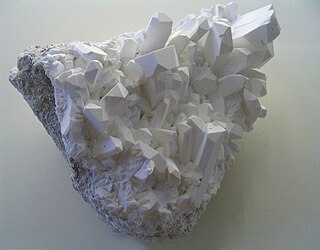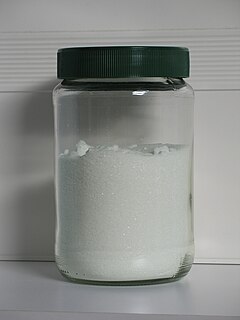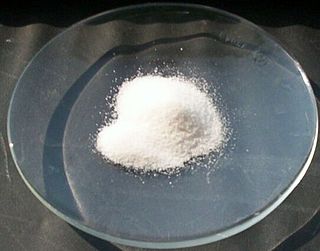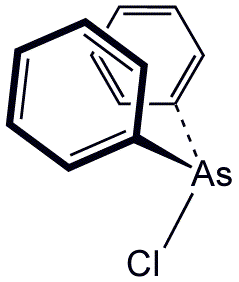Related Research Articles

Agent Orange is a herbicide and defoliant chemical, one of the "tactical use" Rainbow Herbicides. It is widely known for its use by the U.S. military as part of its chemical warfare program, Operation Ranch Hand, during the Vietnam War from 1961 to 1971. It is a mixture of equal parts of two herbicides, 2,4,5-T and 2,4-D. In addition to its damaging environmental effects, traces of dioxin found in the mixture have caused major health problems for many individuals who were exposed.
Nerve agents, sometimes also called nerve gases, are a class of organic chemicals that disrupt the mechanisms by which nerves transfer messages to organs. The disruption is caused by the blocking of acetylcholinesterase, an enzyme that catalyzes the breakdown of acetylcholine, a neurotransmitter.

Borax, also known as sodium borate, sodium tetraborate, or disodium tetraborate, is a compound with formula Na
2H
4B
4O
9•nH
2O or, more precisely, [Na•(H
2O)+
m]
2[B
4O
5(OH)2−
4].

Sarin is an extremely toxic synthetic organophosphorus compound. A colourless, odourless liquid, it is used as a chemical weapon due to its extreme potency as a nerve agent. Exposure is lethal even at very low concentrations, where death can occur within one-to-ten minutes after direct inhalation of a lethal dose, due to suffocation from lung muscle paralysis, unless antidotes are quickly administered. People who absorb a non-lethal dose, but do not receive immediate medical treatment, may suffer permanent neurological damage.

Aberdeen Proving Ground (APG) is a U.S. Army facility located adjacent to Aberdeen, Harford County, Maryland, United States. Part of the facility is a census-designated place (CDP), which had a population of 3,116 at the 2000 census, and 2,093 as of the 2010 census.
An antiemetic is a drug that is effective against vomiting and nausea. Antiemetics are typically used to treat motion sickness and the side effects of opioid analgesics, general anaesthetics, and chemotherapy directed against cancer. They may be used for severe cases of gastroenteritis, especially if the patient is dehydrated.

VX is an extremely toxic synthetic chemical compound in the organophosphorus class, specifically, a thiophosphonate. In the class of nerve agents, it was developed for military use in chemical warfare after translation of earlier discoveries of organophosphate toxicity in pesticide research. In its pure form, VX is an oily, relatively non-volatile, liquid that is amber-like in color. Because of its low volatility, VX persists in environments where it is dispersed.

Lewisite (L) is an organoarsenic compound. It was once manufactured in the U.S., Japan, Germany and the Soviet Union for use as a chemical weapon, acting as a vesicant and lung irritant. Although colorless and odorless, impure samples of lewisite are a yellow, brown, violet-black, green, or amber oily liquid with a distinctive odor that has been described as similar to geraniums.

Copper(II) sulfate, also known as copper sulphate, are the inorganic compounds with the chemical formula CuSO4(H2O)x, where x can range from 0 to 5. The pentahydrate (x = 5) is the most common form. Older names for this compound include blue vitriol, bluestone, vitriol of copper, and Roman vitriol.

Amitriptyline, sold under the brand name Elavil among others, is a medicine primarily used to treat a number of mental illnesses. These include major depressive disorder and anxiety disorders, and less commonly attention deficit hyperactivity disorder (ADHD) and bipolar disorder. Other uses include prevention of migraines, treatment of neuropathic pain such as fibromyalgia and postherpetic neuralgia, and less commonly insomnia. It is in the tricyclic antidepressant (TCA) class and its exact mechanism of action is unclear. Amitriptyline is taken by mouth.
Cyanogen chloride is a toxic chemical compound with the formula NCCl. This linear, triatomic pseudohalogen is an easily condensed colorless gas. More commonly encountered in the laboratory is the related compound cyanogen bromide, a room-temperature solid that is widely used in biochemical analysis and preparation.
Novichok is a series of binary chemical weapons developed by the Soviet Union and Russia between 1971 and 1993. Russian scientists who developed the nerve agents claim they are the deadliest ever made, with some variants possibly five to eight times more potent than VX, and others up to ten times more potent than soman.

Sodium chlorite (NaClO2) is a chemical compound used in the manufacturing of paper and as a disinfectant.

Arsenic trioxide, sold under the brand name Trisenox among others, is an inorganic compound and medication. As an industrial chemical, major uses include in the manufacture of wood preservatives, pesticides, and glass. As a medication it is used to treat a type of cancer known as acute promyelocytic leukemia. For this use it is given by injection into a vein.

Adamsite or DM is an organic compound; technically, an arsenical diphenylaminechlorarsine, that can be used as a riot control agent. DM belongs to the group of chemical warfare agents known as vomiting agents or sneeze gases. First synthesized in Germany by Heinrich Otto Wieland in 1915, it was independently developed by the US chemist Roger Adams at the University of Illinois in 1918.

Diphenylchloroarsine (DA) is the organoarsenic compound with the formula (C6H5)2AsCl. It is highly toxic and was once used in chemical warfare. It is also an intermediate in the preparation of other organoarsenic compounds. The molecule consists of a pyramidal As(III) center attached to two phenyl rings and one chloride.

Phenyldichloroarsine, NATO abbreviation PD, is an organic arsenical vesicant and vomiting agent developed by Germany and France for use as a chemical warfare agent during World War I. The agent is known by multiple synonyms and is technically classified as a vesicant, or blister agent.
Cholinesterase inhibitors, also known as anti-cholinesterase, are chemicals that prevent the breakdown of the neurotransmitter acetylcholine or butyrylcholine. This increases the amount of the acetylcholine or butyrylcholine in the synaptic cleft that can bind to muscarinic receptors, nicotinic receptors and others. This group of inhibitors are divided into two subgroups, acetylcholinesterase inhibitors and butyrylcholinesterase inhibitors.
The Aoji-ri Chemical Complex is a large industrial complex in Haksong-ri, Kyŏnghŭng county, South P'yŏngan province, North Korea, which produces about 51 different products, including methane, ammonia, ammonium bicarbonate, and coal tar derivatives. It also allegedly produces blood agents and vomiting agents, including Adamsite.

A-234 is an organophosphate nerve agent. It was developed in the Soviet Union under the FOLIANT program and is one of the group of compounds referred to as Novichok agents that were revealed by Vil Mirzayanov. In March 2018 the Russian ambassador to the UK, Alexander Yakovenko, claimed to have been informed by British authorities that A-234 had been identified as the agent used in the poisoning of Sergei and Yulia Skripal. Vladimir Uglev, one of the inventors of the Novichok series of compounds, said he was "99 per cent sure that it was A-234" in relation to the 2018 Amesbury poisonings, noting its unusually high persistence in the environment.
References
- ↑ John Brighton (2002). Natural Forms of Defense Against Biological, Chemical and Nuclear Threats. Trafford. p. 175. ISBN 978-1-55369-593-6.
- ↑ "Vomiting agents". ScienceDirect . Retrieved 4 July 2018.
- ↑ Christopher P Holstege (6 August 2015). Zygmunt F Dembek (ed.). "CBRNE - Vomiting Agents - Dm, Da, Dc". Medscape . Retrieved 4 July 2018.
- ↑ Daniel E. Glick (2008). ALS for the BLS Provider Field Guide. American Academy of Orthopaedic Surgeons/Jones and Bartlett. p. 90. ISBN 978-0-7637-5171-5.
| This article related to weaponry is a stub. You can help Wikipedia by expanding it. |